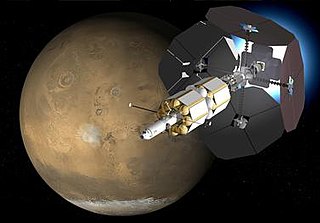Space Nuclear Thermal Propulsion Program







In contrast to the TIMBER WIND project, the Space Nuclear Thermal Propulsion (SNTP) program was intended to develop upper-stages for space-lift which would not operate within the Earth's atmosphere. SNTP failed to achieve its objective of flight testing a nuclear thermal upper-stage, and was terminated in January 1994. [13] The program involved coordinating efforts across the Department of Defense, the Department of Energy, and their contractors from operating sites across the U.S. A major accomplishment of the program was to coordinate Environmental Protection Agency approvals for ground testing at two possible sites. [14]
| Name | Location | Responsibilities |
|---|---|---|
| Brookhaven National Laboratory | Upton, NY | Reactor materials and components testing; thermal-hydraulic, and neutronic analysis; reactor design studies [12] |
| Babcock & Wilcox | Lynchburg, VA | Reactor design testing, fabrication and assembly |
| Sandia National Labs | Albuquerque, NM | Nuclear safety, nuclear instrumentation and operation, reactor control system modeling, nuclear testing |
| Aerojet Propulsion Division | Sacramento, CA | Fuel element alternate materials development |
| Hercules Aerospace Corporation | Magna, UT | Design and fabrication of engine lower structure and nozzle |
| Garrett Fluid Systems Division | Tempe, AZ and San Tan, AZ | Design and fabrication of attitude control system, propellant flow control system and turbopump assembly |
| AiResearch Los Angeles Division of Allied Signal | Torrance, CA | Turbine wheel testing |
| Grumman Space Electronics Division | Bethpage, NY | Vehicle design and fabrication, systems integration |
| Raytheon Services Nevada | Las Vegas, NV | Facility and Coolant Supply System (CSS) engineering, facility construction management |
| Reynolds Electrical and Engineering Company, Inc | Las Vegas, NV | Facility construction |
| Fluor-Daniel, Inc. | Irvine, CA | Effluent Treatment System (ETS) engineering |
| Sandia National Labs | Saddle Mountain Test Site or QUEST or LOFT Sites | Test site preparation, planning and performance of engine ground tests, nuclear component testing |
| [REDACTED] | Washington, DC | Program management |
| DoE Headquarters | Washington, DC | Program management, nuclear safety assurance |
| DoE Nevada Test Site | Las Vegas, NV | Ground testing |
| DoE Idaho National Engineering Lab | Idaho Falls, ID | Ground testing |
| U.S. Air Force Phillips Lab | Albuquerque, NM | Program management |
| U.S. Army Corps of Engineers | Huntsville, AL | ETS engineering management |
| Los Alamos National Laboratory | Los Alamos, NM | Fuels and materials testing |
| Marshall Space Flight Center (NASA) | Huntsville, AL | Material and component simulation/testing |
| Western Test Range/Western Space & Missile Center (USAF) | Vandenberg AFB, CA | Program review |
| Arnold Engineering Development Center | Manchester, TN | Hydrogen flow testing |
| UNC Manufacturing Company | Uncasville, CT | Materials manufacturing |
| Grumman Corporation - Calverton Facility | Long Island, NY | Hydrogen testing |
The planned ground test facilities were estimated to cost $400M of additional funding to complete in 1992. [15] Fewer than 50 sub-scale tests were planned over three to four years, followed by facility expansions to accommodate five to 25 1000 second full-scale tests of a 2000MW engine. [14]
Initially, PIPET [Particle Bed Reactor Integral Performance Element Tester] was envisioned as a small, low-cost, SNTP-specific experiment for testing and qualifying PBR fuel and fuel elements. The demands by other agencies, DOE and NASA, resulted in a national test facility for NTP fuel, fuel elements, and engines. Its size out grew the SNTP Program's ability to secure the funds for such a large construction project. Though the demands were placed upon the SNTP Program to expand the facility's scope and the SNTP Program's management tried to coordinate tri-agency, DoD-DOE-NASA, support and funding, adequate funding support for the national ground test facility was not obtained.
— SNTP Final Report, [13]
The program had technical achievements as well, such as developing high-strength fibers, and carbide coatings for Carbon-Carbon composites. The hot-section design evolved to use all Carbon-Carbon to maximize turbine inlet temperature and minimize weight. Carbon-Carbon has much lower nuclear heating than other candidate materials, so thermal stresses were minimized as well. Prototype turbine components employing a 2-D polar reinforcement weave were fabricated for use in the corrosive, high-temperature hydrogen environment found in the proposed particle bed reactor (PBR)-powered engine. [13] The particle bed reactor concept required significant radiation shielding, not only for the payload, electronics and structure of the vehicle, but also to prevent unacceptable boil-off of the cryogenic propellant. A propellant-cooled, composite shield of Tungsten, which attenuates gamma rays and absorbs thermal neutrons, and Lithium Hydride, which has a large scattering cross section for fast and thermal neutrons was found to perform well with low mass compared to older Boron Aluminum Titanium Hydride (BATH) shields. [16]
Sandia National Labs was responsible for qualification of the coated particle fuel for use in the SNTP nuclear thermal propulsion concept. [15]
| Pro | Con | |
|---|---|---|
| Bleed Cycle |
| Development of high temp turbine and feed lines required |
| Partial Flow Expander Cycle |
|
|









